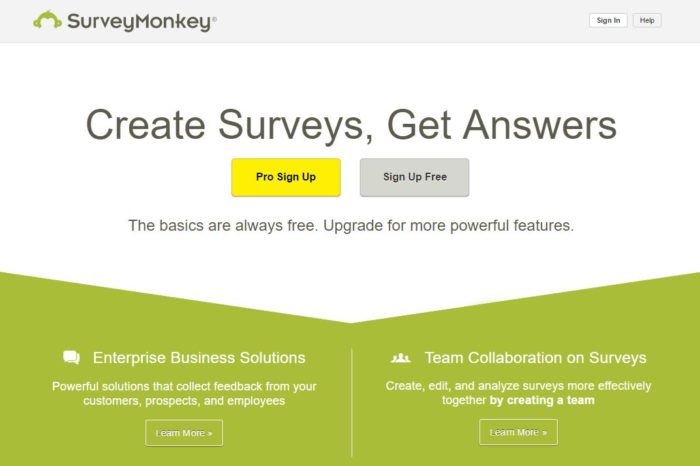Here at Digital Branding Institute, we wanted to learn more about who our audience is and what their digital branding needs are, but the process was a big undertaking. Take a look and see how to effectively survey your audience.
The Who, What, Where, When, Why, and How to Survey Your Audience.
About once a year, we try to survey our audience. Sending out a survey helps us see any changes in our demographics or trends. It also helps us see any content gaps that we need to address. We decided that it was time to send a survey out to our subscribers to learn more about them.
The Who: Our Audience
When you survey your audience, if you don’t have a central mission, then your results are not going to be as insightful. Our goal was to look at the demographics of our audience, which of our products/services they are utilizing, and what their current digital branding needs are.
The What: A Survey
There are many great (and cheap, if not free!) ways to get customer feedback. We decided that we wanted to do a formal survey because we had lots of questions we wanted to include.
If you want to get demographics from your audience, you can also use a survey. Another option would be to require your website users to fill out 3-4 demographics questions as a pop-up form for all unique users. This is great as it will capture the information for you, and will be easy to analyze.
If you want to ask a product or service related question, that can be as simple as a post on your social media accounts. Then, you will have to analyze the results yourself by going through the comments.
Like I said earlier, we wanted to find out more about the demographics of our audience. We also wanted to know what products and services of ours they were using, and what their current digital branding knowledge and needs are. This required a more in-depth approach, so we used a survey.
There are many great online tools to use, read more about these tools here.
We decided to use Survey Monkey because we were able to format the survey the way we wanted. However, the free Survey Monkey tool only allows you to analyze the results per question, not as a whole. If you want to analyze multiple questions together, you will need to upgrade your account.

The Where: Email
We sent this survey out through an email to our audience list and received over 200 participants. If you do not have your audience’s emails or any email lists, you can purchase them through some survey tools, or you can also post the link to your survey on your social media accounts.
The When: Once a year
We try and send our survey out to our email list once a year. Decide what works best for your audience and schedule your survey accordingly.
You should also consider the day of the week and what time of day to send your survey to your audience to get the best results. If you already send emails out to your consumers, use those open rates as a benchmark for your survey email.
If you don’t have any benchmarks, most people have the time to take surveys later in the evening.
The Why: Understanding our Audience
Here at the Digital Branding Institute, we write blog posts, create products, and offer services to help our consumers improve their digital branding.
To do this, we need to make sure that we are continually serving content that is relevant to our readers, make sure we have products that met our consumer’s needs, and make sure we have services that reflect where our consumers need help.
Understanding our audience is as key to our success as it is to yours.
The How: Questions
Our survey consisted of 27 questions, and we used a mixture of multiple-choice and fill-in questions.
The type of question is important when creating a survey, as is question order. You don’t want to give your audience survey fatigue and have them leave before completing the whole thing, so being aware of your audience’s time is important.
Multiple-choice questions are easier and faster for your audience to answer. These are also easy for you to analyze. However, there is no depth to these questions. If you have a straightforward question, using multiple-choice is a great option.
Fill-in questions are harder for your audience to answer because it requires more work on their part. They are also harder for you to analyze, as you will have to do this manually. However, these questions can provide far more insight than multiple-choice. You might think you have listed all the options to a question, but by leaving the answer open ended, the results might be surprising and provide better depth and understanding.
Excellent surveys will include a mix of multiple-choice and fill-in. Also, it is important to consider question order.
In our survey, we wanted to see the demographics of our audience, which is why we put those questions at the front of our survey. Generally, demographics questions should go at the end of the questionnaire.
It is also important to avoid survey bias. Your questions should not in any way lead the participant to feel they need to answer in a particular manner. An example of this is feeling like they will be judged if they don’t “answer correctly.”
Humans by nature want to be liked. If your participants feel that there is a “right answer,” they will be more likely to choose it, even if it does not reflect their thoughts or beliefs.
Types of questions avoid:
Leading questions:
BAD: How bad was the pizza?
GOOD: How would you describe the pizza?
Loaded questions:
BAD: What is your favorite beer?
This assumes that the participant drinks beer, which might not be the case. You should first ask if the participant likes beer, then use skip logic through the survey platform. If the participant answers yes, you can lead them to the favorite beer question. If they answer no, they will skip to the next question you want them to answer.
Double–barreled questions:
BAD: How much do you like pizza AND French fries?
Good: How much do you like pizza?
Your question should only have one subject.
Absolutes in questions:
BAD: Do you always brush your teeth?
GOOD: How often do you brush your teeth a day?
Also always remember to make sure there is no ambiguities or confusing language. Define things that need a definition, such as a term or if you want the participant to base their answer on how often they do something a day, a week, a year, etc.
Have you ever run a survey for your business? Have any tips?











